Abstract
Senescent human diploid cells (HDC) were fused to replicative transformed cells of different types, and DNA synthesis was monitored in the resulting heterodikaryons. Human cells transformed by simian virus 40 or adenovirus serotype 5 were able to induce DNA synthesis in senescent HDC nuclei in heterodikaryons. In contrast, carcinogen-transformed cells were not able to induce DNA synthesis in senescent HDC nuclei; rather, the transformed nuclei in these heterodikaryons were inhibited from entering S phase. Cells transformed by Rous sarcoma virus and most human tumor cells tested are similarly inhibited by fusion to senescent HDC. These results suggest that the mechanism for transformation by DNA tumor viruses may be fundamentally different from that of other viruses and carcinogens and from that of most human tumor cells. A simple model to explain these results is that (i) senescent HDC contain an inhibitor of entry into S phase; (ii) cells transformed by DNA tumor viruses have gained a transforming factor, perhaps large tumor antigen, that is capable of overriding the normal inhibitor; and (iii) cells transformed by carcinogens or RNA viruses have lost or altered the mechanism for expression of the normal inhibitor yet are still sensitive to it. We propose that this inhibitor is produced in normal cells when they experience conditions that are inadequate for proliferation and that it plays a role in putting the cells into a distinct quiescent state with long-term viability. The override of this inhibitor function in simian virus 40-transformed HDC can explain why they have low viability in plateau-phase cultures and why they die during crisis.
Full text
PDF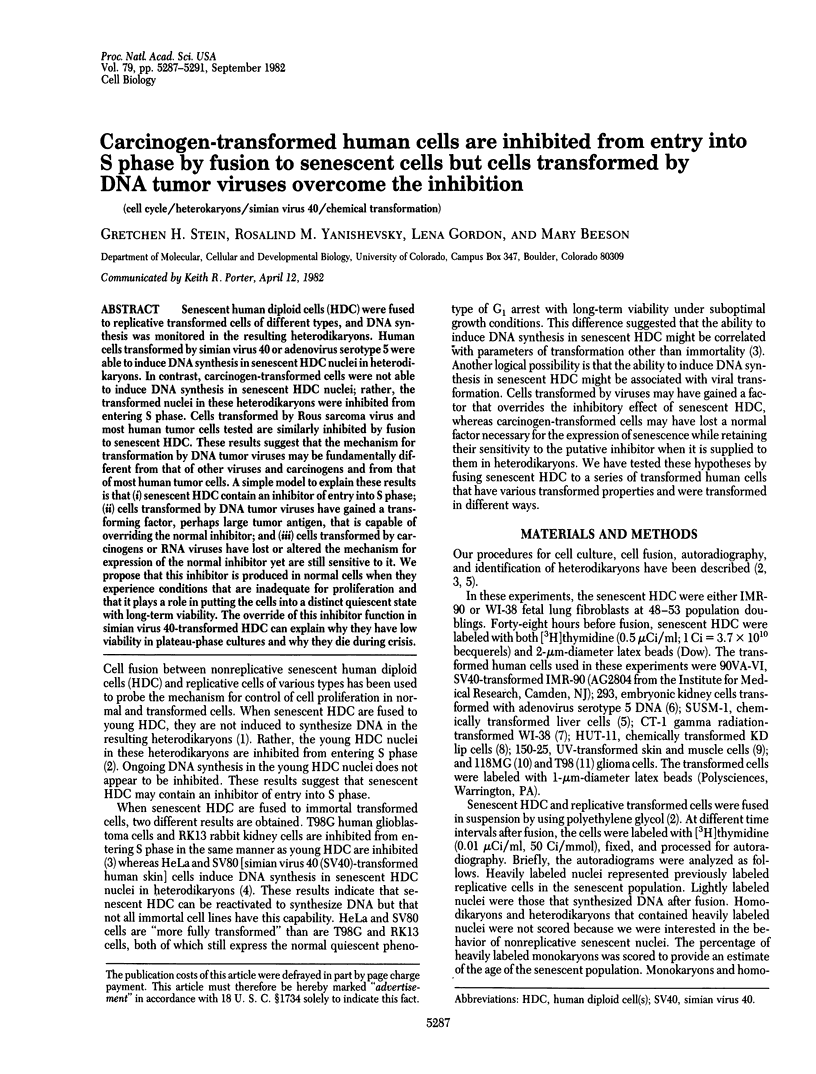
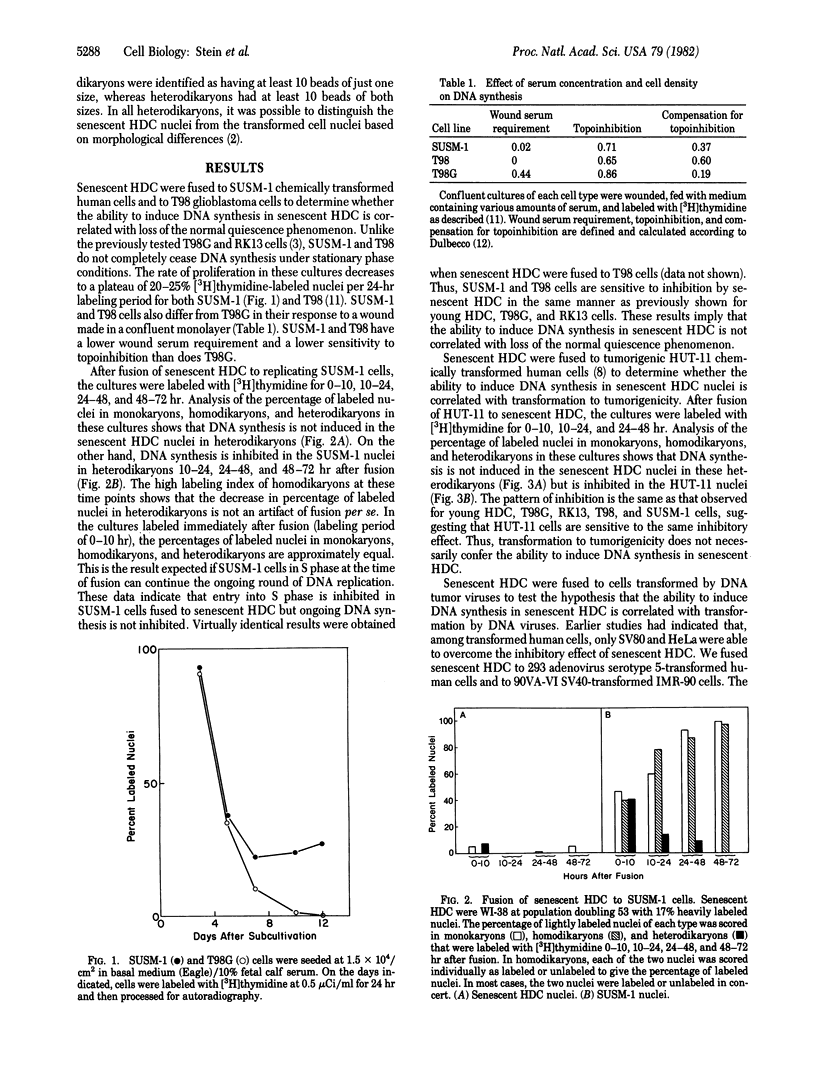
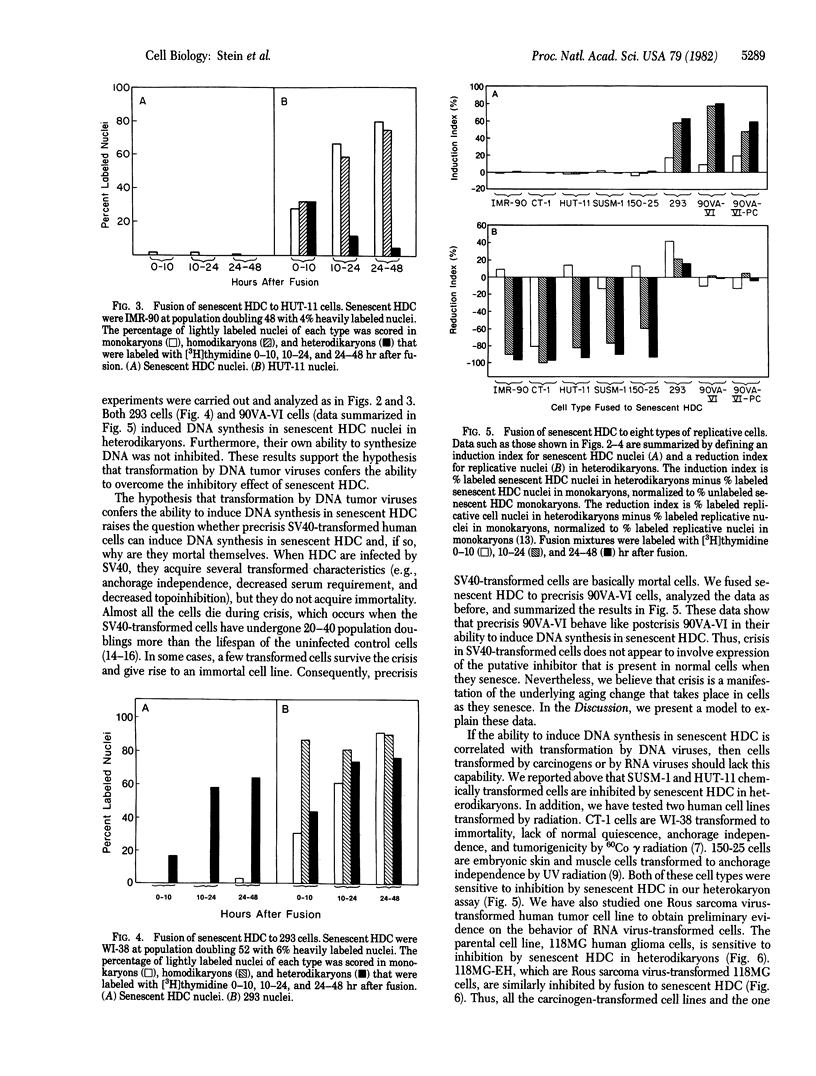
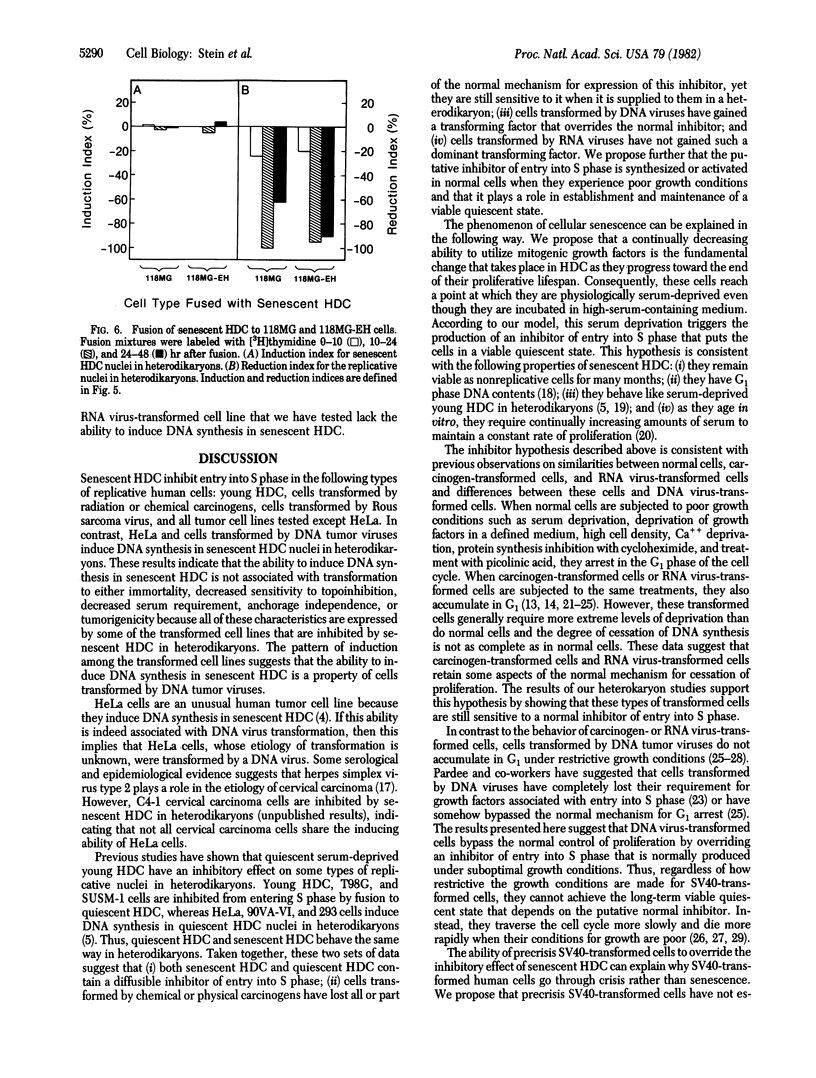
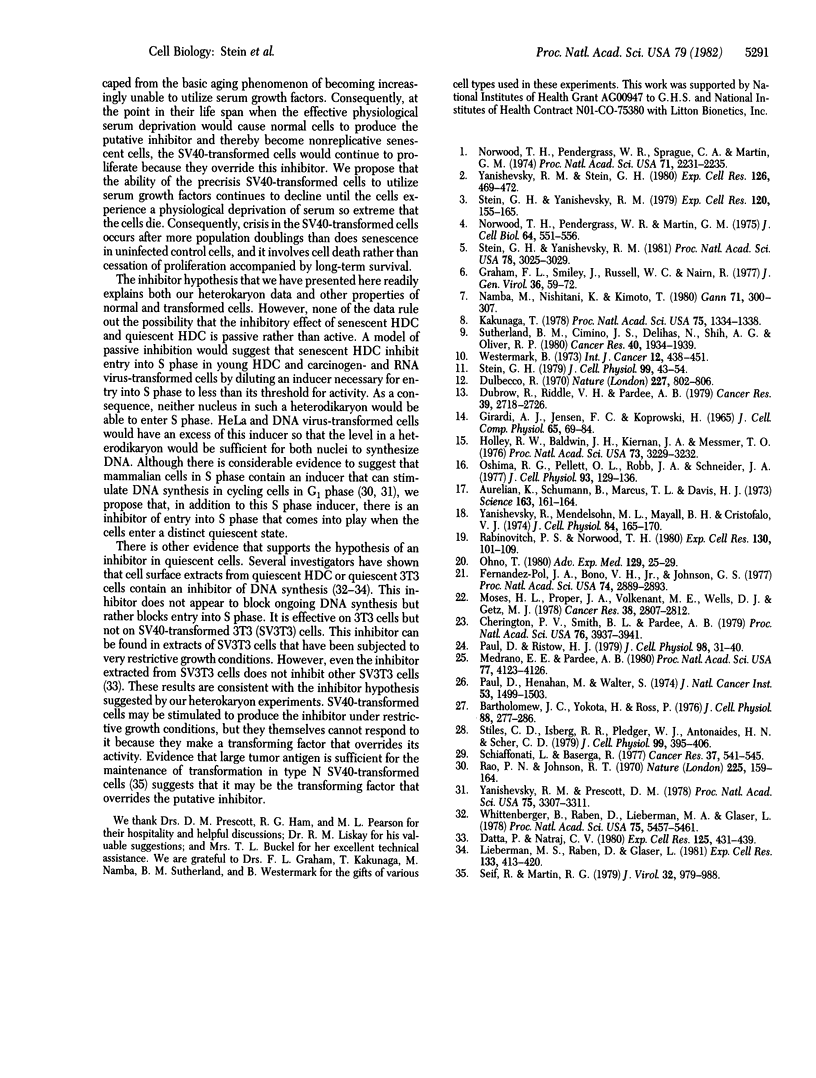
Selected References
These references are in PubMed. This may not be the complete list of references from this article.
- Aurelian L., Schumann B., Marcus R. L., Davis H. J. Antibody to HSV-2 induced tumor specific antigens in serums from patients with cervical carcinoma. Science. 1973 Jul 13;181(4095):161–164. doi: 10.1126/science.181.4095.161. [DOI] [PubMed] [Google Scholar]
- Bartholomew J. C., Yokota H., Ross P. Effect of serum on the growth of Balb oT3 A31 mouse fibroblasts and an SV40-transformed derivative. J Cell Physiol. 1976 Jul;88(3):277–286. doi: 10.1002/jcp.1040880303. [DOI] [PubMed] [Google Scholar]
- Cherington P. V., Smith B. L., Pardee A. B. Loss of epidermal growth factor requirement and malignant transformation. Proc Natl Acad Sci U S A. 1979 Aug;76(8):3937–3941. doi: 10.1073/pnas.76.8.3937. [DOI] [PMC free article] [PubMed] [Google Scholar]
- Datta P., Natraj C. V. Fibroblast growth regulatory factor inhibits DNA synthesis in BALB/c 3T3 cells by arresting in G1. Exp Cell Res. 1980 Feb;125(2):431–439. doi: 10.1016/0014-4827(80)90137-8. [DOI] [PubMed] [Google Scholar]
- Dubrow R., Riddle V. G., Pardee A. B. Different responses to drugs and serum of cells transformed by various means. Cancer Res. 1979 Jul;39(7 Pt 1):2718–2726. [PubMed] [Google Scholar]
- Dulbecco R. Topoinhibition and serum requirement of transformed and untransformed cells. Nature. 1970 Aug 22;227(5260):802–806. doi: 10.1038/227802a0. [DOI] [PubMed] [Google Scholar]
- Fernandez-Pol J. A., Bono V. H., Jr, Johnson G. S. Control of growth by picolinic acid: differential response of normal and transformed cells. Proc Natl Acad Sci U S A. 1977 Jul;74(7):2889–2893. doi: 10.1073/pnas.74.7.2889. [DOI] [PMC free article] [PubMed] [Google Scholar]
- GIRARDI A. J., JENSEN F. C., KOPROWSKI H. SV40-INDUCED TRANFORMATION OF HUMAN DIPLOID CELLS: CRISIS AND RECOVERY. J Cell Physiol. 1965 Feb;65:69–83. doi: 10.1002/jcp.1030650110. [DOI] [PubMed] [Google Scholar]
- Graham F. L., Smiley J., Russell W. C., Nairn R. Characteristics of a human cell line transformed by DNA from human adenovirus type 5. J Gen Virol. 1977 Jul;36(1):59–74. doi: 10.1099/0022-1317-36-1-59. [DOI] [PubMed] [Google Scholar]
- Holley R. W., Baldwin J. H., Kiernan J. A., Messmer T. O. Control of growth of benzo(a)pyrene-transformed 3T3 cells. Proc Natl Acad Sci U S A. 1976 Sep;73(9):3229–3232. doi: 10.1073/pnas.73.9.3229. [DOI] [PMC free article] [PubMed] [Google Scholar]
- Kakunaga T. Neoplastic transformation of human diploid fibroblast cells by chemical carcinogens. Proc Natl Acad Sci U S A. 1978 Mar;75(3):1334–1338. doi: 10.1073/pnas.75.3.1334. [DOI] [PMC free article] [PubMed] [Google Scholar]
- Lieberman M. A., Raben D., Glaser L. Cell surface-associated growth inhibitory proteins. Exp Cell Res. 1981 Jun;133(2):413–419. doi: 10.1016/0014-4827(81)90334-7. [DOI] [PubMed] [Google Scholar]
- Medrano E. E., Pardee A. B. Prevalent deficiency in tumor cells of cycloheximide-induced cycle arrest. Proc Natl Acad Sci U S A. 1980 Jul;77(7):4123–4126. doi: 10.1073/pnas.77.7.4123. [DOI] [PMC free article] [PubMed] [Google Scholar]
- Moses H. L., Proper J. A., Volkenant M. E., Wells D. J., Getz M. J. Mechanism of growth arrest of chemically transformed cells in culture. Cancer Res. 1978 Sep;38(9):2807–2812. [PubMed] [Google Scholar]
- Namba M., Nishitani K., Kimoto T. Characteristics of WI-38 cells (WI-38 CT-1) transformed by treatment with Co-60 gamma rays. Gan. 1980 Jun;71(3):300–307. [PubMed] [Google Scholar]
- Norwood T. H., Pendergrass W. R., Martin G. M. Reinitiation of DNA synthesis in senescent human fibroblasts upon fusion with cells of unlimited growth potential. J Cell Biol. 1975 Mar;64(3):551–556. doi: 10.1083/jcb.64.3.551. [DOI] [PMC free article] [PubMed] [Google Scholar]
- Norwood T. H., Pendergrass W. R., Sprague C. A., Martin G. M. Dominance of the senescent phenotype in heterokaryons between replicative and post-replicative human fibroblast-like cells. Proc Natl Acad Sci U S A. 1974 Jun;71(6):2231–2235. doi: 10.1073/pnas.71.6.2231. [DOI] [PMC free article] [PubMed] [Google Scholar]
- Ohno T. Change of responsiveness to growth stimulation of normal cells during aging. Adv Exp Med Biol. 1980;129:25–29. doi: 10.1007/978-1-4684-3734-8_3. [DOI] [PubMed] [Google Scholar]
- Oshima R. G., Pellett O. L., Robb J. A., Schneider J. A. Transformation of human cystinotic fibroblasts by SV40: characteristics of transformed cells with limited and unlimited growth potential. J Cell Physiol. 1977 Oct;93(1):129–136. doi: 10.1002/jcp.1040930116. [DOI] [PubMed] [Google Scholar]
- Paul D., Henahan M., Walter S. Changes in growth control and growth requirements associated with neoplastic transformation in vitro. J Natl Cancer Inst. 1974 Nov;53(5):1499–1503. doi: 10.1093/jnci/53.5.1499. [DOI] [PubMed] [Google Scholar]
- Paul D., Ristow H. J. Cell cycle control by Ca++-ions in mouse 3T3 cells and in transformed 3T3 cells. J Cell Physiol. 1979 Jan;98(1):31–39. doi: 10.1002/jcp.1040980105. [DOI] [PubMed] [Google Scholar]
- Rabinovitch P. S., Norwood T. H. Comparative heterokaryon study of cellular senescence and the serum-deprived state. Exp Cell Res. 1980 Nov;130(1):101–109. doi: 10.1016/0014-4827(80)90046-4. [DOI] [PubMed] [Google Scholar]
- Rao P. N., Johnson R. T. Mammalian cell fusion: studies on the regulation of DNA synthesis and mitosis. Nature. 1970 Jan 10;225(5228):159–164. doi: 10.1038/225159a0. [DOI] [PubMed] [Google Scholar]
- Schiaffonati L., Baserga R. Different survival of normal and transformed cells exposed to nutritional conditions nonpermissive for growth. Cancer Res. 1977 Feb;37(2):541–545. [PubMed] [Google Scholar]
- Seif R., Martin R. G. Simian virus 40 small t antigen is not required for the maintenance of transformation but may act as a promoter (cocarcinogen) during establishment of transformation in resting rat cells. J Virol. 1979 Dec;32(3):979–988. doi: 10.1128/jvi.32.3.979-988.1979. [DOI] [PMC free article] [PubMed] [Google Scholar]
- Stein G. H. T98G: an anchorage-independent human tumor cell line that exhibits stationary phase G1 arrest in vitro. J Cell Physiol. 1979 Apr;99(1):43–54. doi: 10.1002/jcp.1040990107. [DOI] [PubMed] [Google Scholar]
- Stein G. H., Yanishevsky R. M. Entry into S phase is inhibited in two immortal cell lines fused to senescent human diploid cells. Exp Cell Res. 1979 Apr;120(1):155–165. doi: 10.1016/0014-4827(79)90546-9. [DOI] [PubMed] [Google Scholar]
- Stein G. H., Yanishevsky R. M. Quiescent human diploid cells can inhibit entry into S phase in replicative nuclei in heterodikaryons. Proc Natl Acad Sci U S A. 1981 May;78(5):3025–3029. doi: 10.1073/pnas.78.5.3025. [DOI] [PMC free article] [PubMed] [Google Scholar]
- Stiles C. D., Isberg R. R., Pledger W. J., Antoniades H. N., Scher C. D. Control of the Balb/c-3T3 cell cycle by nutrients and serum factors: analysis using platelet-derived growth factor and platelet-poor plasma. J Cell Physiol. 1979 Jun;99(3):395–405. doi: 10.1002/jcp.1040990314. [DOI] [PubMed] [Google Scholar]
- Sutherland B. M., Cimino J. S., Delihas N., Shih A. G., Oliver R. P. Ultraviolet light-induced transformation of human cells to anchorage-independent growth. Cancer Res. 1980 Jun;40(6):1934–1939. [PubMed] [Google Scholar]
- Westermark B. The deficient density-dependent growth control of human malignant glioma cells and virus-transformed glia-like cells in culture. Int J Cancer. 1973 Sep 15;12(2):438–451. doi: 10.1002/ijc.2910120215. [DOI] [PubMed] [Google Scholar]
- Whittenberger B., Raben D., Lieberman M. A., Glaser L. Inhibition of growth of 3T3 cells by extract of surface membranes. Proc Natl Acad Sci U S A. 1978 Nov;75(11):5457–5461. doi: 10.1073/pnas.75.11.5457. [DOI] [PMC free article] [PubMed] [Google Scholar]
- Yanishevsky R. M., Prescott D. M. Late S phase cells (Chinese hamster ovary) induce early S phase DNA labeling patterns in G1 phase nuclei. Proc Natl Acad Sci U S A. 1978 Jul;75(7):3307–3311. doi: 10.1073/pnas.75.7.3307. [DOI] [PMC free article] [PubMed] [Google Scholar]
- Yanishevsky R. M., Stein G. H. Ongoing DNA synthesis continues in young human diploid cells (HDC) fused to senescent HDC, but entry into S phase is inhibited. Exp Cell Res. 1980 Apr;126(2):469–472. doi: 10.1016/0014-4827(80)90290-6. [DOI] [PubMed] [Google Scholar]
- Yanishevsky R., Mendelsohn M. L., Mayall B. H., Cristofalo V. J. Proliferative capacity and DNA content of aging human diploid cells in culture: a cytophotometric and autoradiographic analysis. J Cell Physiol. 1974 Oct;84(2):165–170. doi: 10.1002/jcp.1040840202. [DOI] [PubMed] [Google Scholar]


